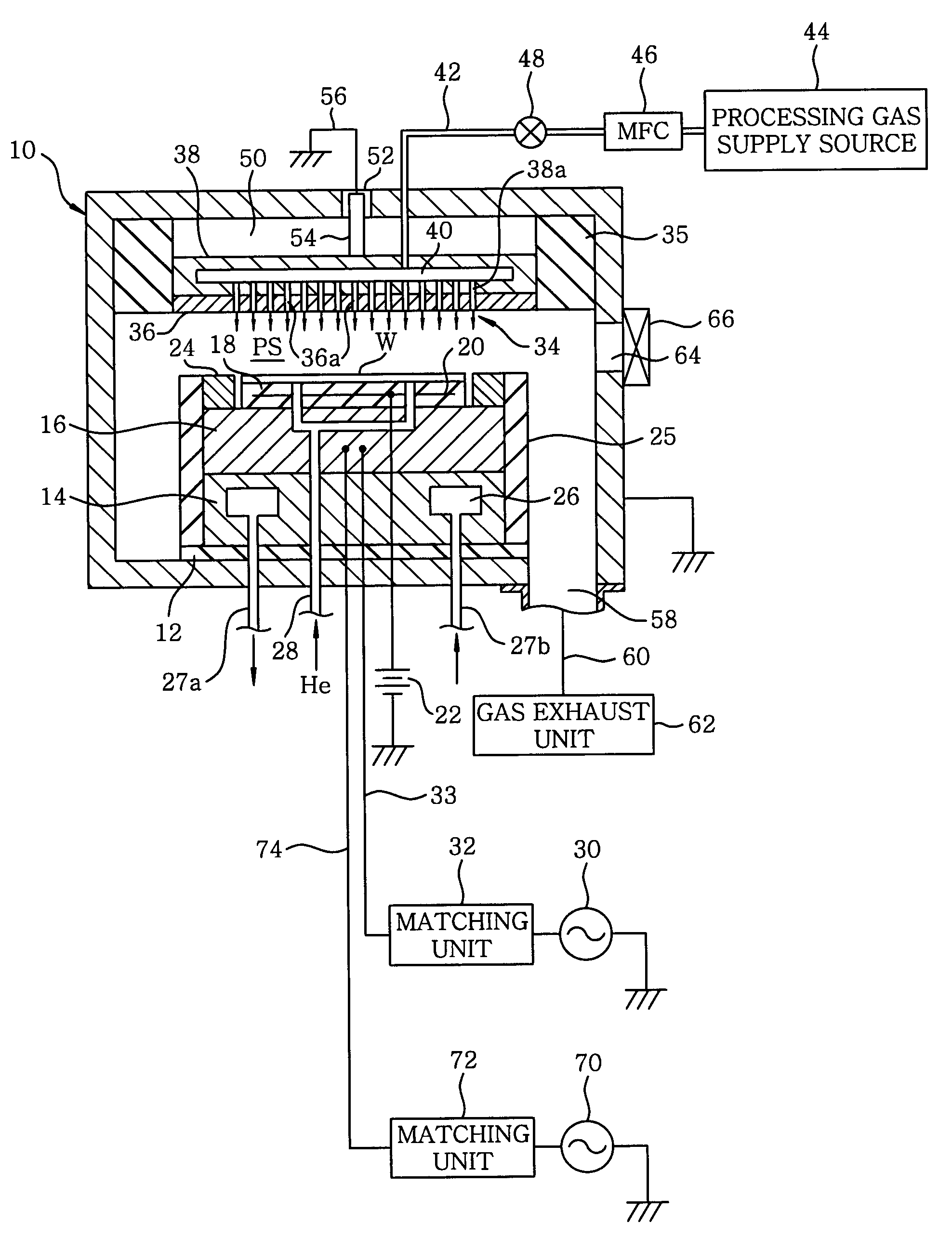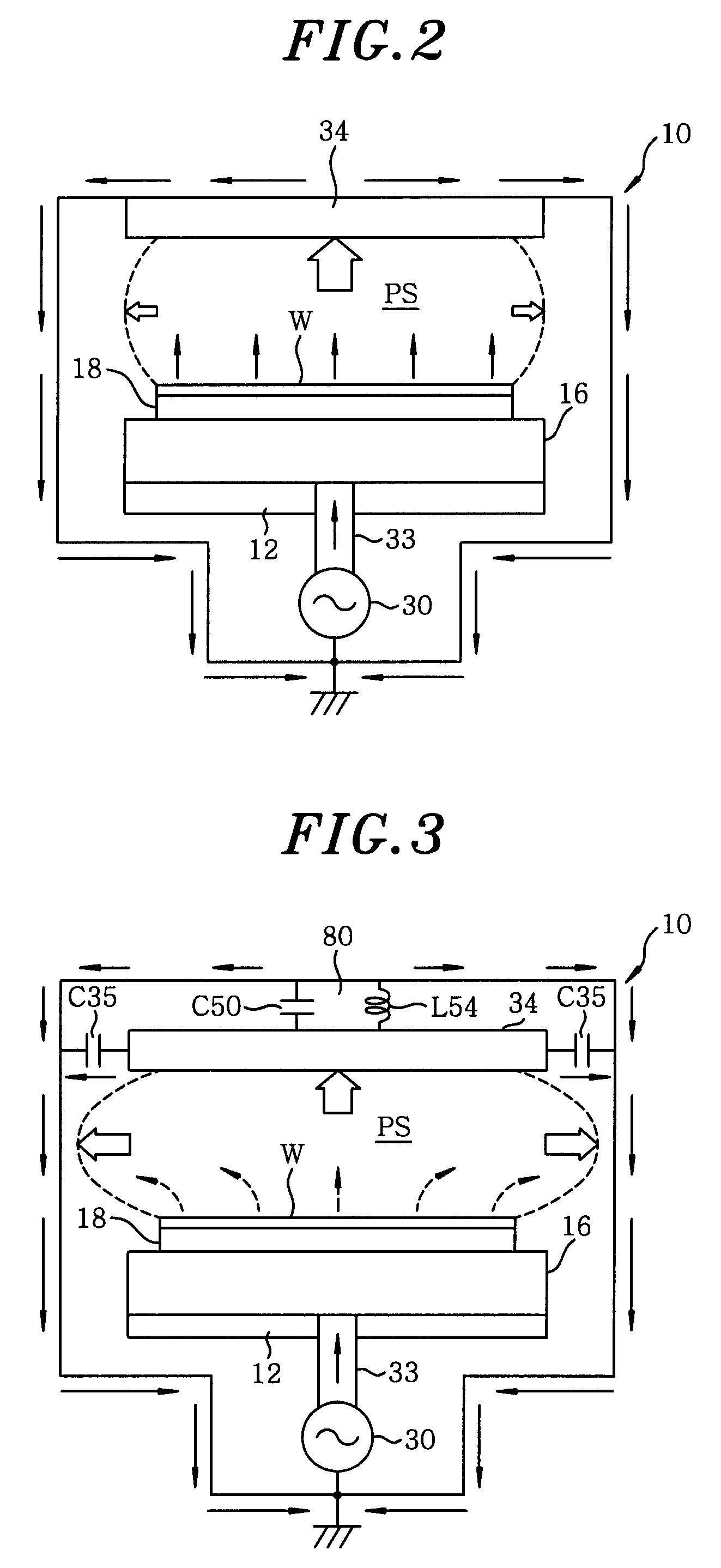Plasma processing apparatus and plasma processing method
a plasma processing apparatus and plasma technology, applied in the field of plasma processing apparatus and plasma processing method, can solve the problems of non-uniform radial direction of process characteristics, achieve the effect of preventing or suppressing undesired films, improving plasma density spatial distribution characteristics or sputtering effects, and improving in-surface uniformity of processes
- Summary
- Abstract
- Description
- Claims
- Application Information
AI Technical Summary
Benefits of technology
Problems solved by technology
Method used
Image
Examples
first embodiment
[0042]FIG. 1 illustrates a configuration of a plasma processing apparatus in accordance with the present invention. The plasma processing apparatus is configured as a capacitively coupled (parallel plate type) plasma processing apparatus of a type in which dual frequency powers are applied to a lower electrode. The plasma processing apparatus has a cylindrical vacuum chamber (processing chamber) 10 made of, e.g., an aluminum whose surface is alumite-treated (anodically oxidized), and the chamber 10 is frame grounded.
[0043]A cylindrical susceptor support 14 is provided at a bottom portion in the chamber 10 via an insulation plate 12 made of ceramic or the like. Further, a susceptor 16 made of, e.g., aluminum, is disposed above the susceptor support 14. The susceptor 16 serves as a lower electrode and a target substrate, e.g., a semiconductor wafer W, is mounted thereon.
[0044]On the top surface of the susceptor 16, there is disposed an electrostatic chuck 18 for attracting and holding...
second embodiment
[0086]In the second embodiment, the serial-parallel LC circuit 94 in the DC filter unit 82 allows the DC voltage from the variable DC power supply 84 to flow therethrough to the upper electrode 34 and generates a serial resonance at a low frequency range (preferably, from 100 kHz to 15 MHz) and a parallel resonance at a radio frequency range (preferably, from 5 MHz to 200 MHz) with respect to the radio frequency from the upper electrode 34. By utilizing such frequency-impedance characteristics of the serial-parallel LC circuit 94, it is possible to further improve the individual functions of the first and the second radio frequency in the dual frequency application type wherein two radio frequency powers are applied to the lower electrode.
[0087]FIG. 10 depicts, as an example, frequency-impedance characteristics Z94 of the serial-parallel LC circuit 94 alone in this embodiment and frequency-impedance characteristics ZA in a radio frequency transmission line from a boundary surface be...
PUM
| Property | Measurement | Unit |
|---|---|---|
| antiresonance frequency | aaaaa | aaaaa |
| antiresonance frequency | aaaaa | aaaaa |
| frequency | aaaaa | aaaaa |
Abstract
Description
Claims
Application Information
 Login to View More
Login to View More - R&D
- Intellectual Property
- Life Sciences
- Materials
- Tech Scout
- Unparalleled Data Quality
- Higher Quality Content
- 60% Fewer Hallucinations
Browse by: Latest US Patents, China's latest patents, Technical Efficacy Thesaurus, Application Domain, Technology Topic, Popular Technical Reports.
© 2025 PatSnap. All rights reserved.Legal|Privacy policy|Modern Slavery Act Transparency Statement|Sitemap|About US| Contact US: help@patsnap.com



